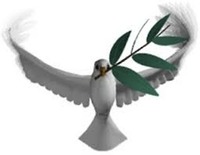
“Hope is the thing with feathers.” Emily Dickinson doesn’t actually mention the dove from Genesis in her famous poem. But how could she not have had this archetypal scene in mind? Is there any more hopeful emblem than that small white bird returning from endless sea with an olive leaf in its beak?
I’m thinking about hope today because someone at a recent bookstore appearance asked about the difference between writing for adults and writing for young readers. I was one of five authors assembled for a panel on Children’s Literature sponsored by the store. And almost all of us agreed that one important difference between a book for children or teens and one for adults is hope.
There is, it seemed to us, a promise of resolution, a potential for growth and change that marks the end of most books for young readers, an end note that isn’t always present in literature for older ones. I’m not talking about happy endings here. We all know that recent kid lit has taken a turn toward truth telling, and even toward the dark side of the truth. Especially in YA novels, protagonists may be left with little or no way out, no chance for change. But almost always, that’s not true of the reader.
Books with classically tragic endings, whether heart-tuggers like John Green’s The Fault In Our Stars or dark comedies like Libba Bray’s Going Bovine, feature protagonists for whom there is no hope. We know from the outset that these characters are doomed. Yet their courageous struggles against the inevitable leave us heartened by human bravery and spirit. By the responsive will to live and love that matches what we find in our own hearts. I call this, the “Charlotte’s Web syndrome,” wherein we know full well that the spider will die, but oh, what a beautiful legacy she spins us before she goes. We can’t help smiling through our tears.
And no, many adult novels do not leave their readers uplifted, so much as weeping for the meaningless nature of our brief and pain-filled lives: Rohinton Mistry’s A Fine Balance and Kazuo Ishiguro’s Never Let Me Go are examples of what I’m inclined to label the Ana Karenina school—books where the readers, as well as the characters, are left with no way out and up, no relief from the dark.
For me, then, hope is what redeems the field of children’s literature, what makes me so deeply committed to it. Again, I’m not talking about telling a reader what to do, or about pretending to them that bad things don’t happen to good people. But what I do see fueling the best (and sometimes the saddest) books for young readers, is empowerment, a way out that allows the reader to celebrate the human spirit, to find it in himself. I think, you see, that young readers need to know that, if they are not being handed a ready-made answer to all their problems, neither are they being abandoned. I’ve spoken to a great many editors at houses that publish children’s books, who’ve told me that that’s what they look for, in addition, of course, to the fine storytelling and compelling characterization that any editor, anywhere, requires. They are constantly hoping to find a new voice and character that speak with, not at a young reader, that offer company and hope, not condescension and sermons.
Not many of us remember that before Noah sent out the dove, he opened a window on the ark and released a raven. The raven never returned. The dove, too, eventually leaves forever, but before she does, she brings back that green token. A sprig of hope. We all have to die. We are all, to that extent, assured a tragic end. But if I have to go, I’d rather go with the bit in my mouth, the green leaf between my teeth. And that’s how I want my characters to go, too!
10 And he stayed yet other seven days; and again he sent forth the dove out of the ark;
(Genesis, King James version)